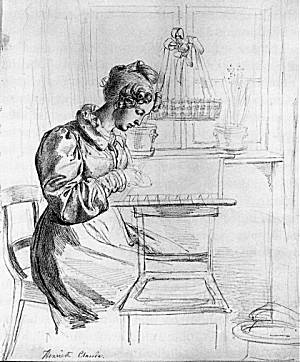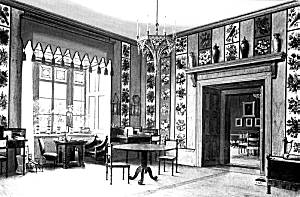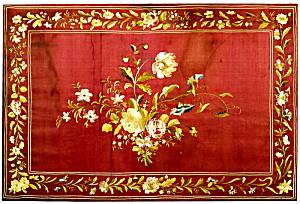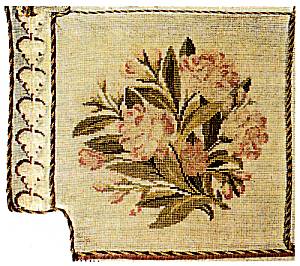
Lady,
embroidering, drawing,
Berlin around 1830, by Louise Henry

Embroidery room
of Princess Marianne of Prussia,
Aquarelle, around 1840, by F. Fischbach
| ANNE WANNER'S Textiles in History / book reviews, articles |
| Berliner Stickereien
des Biedermeier. Entwicklung und gesellschaftliche
Bedeutung, von Uta-Christiane Bergemann, in:
Jahrbuch der Berliner Museen, 2002, erschienen 2004,
Berlin, S. 93-128, 28 pictures (black and white and
coloured), in german language |
| The author points to all the
technical changes occuring from 1800 until 1860, like: - Embroidery technique: crossstitch instead of satin and chain stitch - New type of pattern made on squared paper - Patterns coloured by hand at first and printed later on - Berlin wool was soft and fleecy and capable of taking brilliant dyes - Cotton canvas as a fabric - Development in publishing and editing patterns The main purpose of Bergemann is, trying to answer the question: whether or not the embroidery of 1820 - 1860 was a phenomena of a middle class culture. There are practically no inventories of middle class houses, she therefore deals with fittings and setups of castles in Pottsdam near Berlin. The castle of Charlottenburg was built 1826 - 29 after designs of K.F. Schinkel and specially the living room was decorated with many embroideries. These were worked by the court ladies during social meetings in the evenings. In the years around 1820 embroidery pattern became
very fashionable. Some letters of court ladies of this
period point to the fact that elements of patterns were
put together according to the ladies own opinions.
Motives of the 19th c. had their predecessors in classic
times in the embroidery of nobility, in 19th c. however
precious materials were no longer in use. The
embroideresses came from middle class houses and they
already had an education, knowledge and skill in
embroidery. It very soon also became a possibility of
earning money and also to improve the housekeeping means. In the castle of "Sans Souci", situated in Pottsdam near Berlin as well, the embroideries preserved are too even and equal to be worked by hand. In Berlin some shops sold finished or half finished embroideries. In the course of the 19th c. also the ways of production were simplified, numbers of colours were reduced and there was less variation regarding the motives. |
 Lady,
embroidering, drawing, |
Embroidery room
of Princess Marianne of Prussia, |
 Detail of fire screen, Berlin around 1796 |
 Part
of embroidered sopha, |
Embroidery
pattern, publisher Ludwig Wilhelm Wittich, |
| home content | Last revised January 17, 2005 | For further information contact Anne Wanner wanner@datacomm.ch |